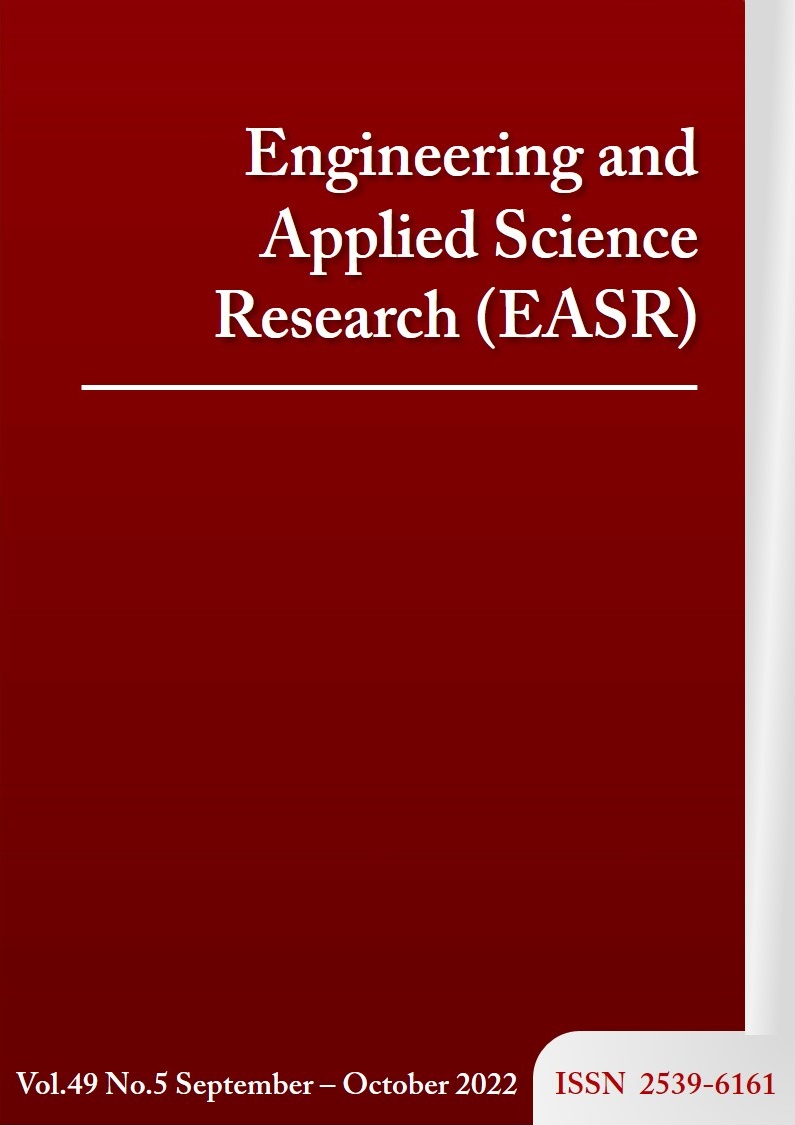Degradation of Penicillin G contaminant in synthesized wastewater by Fenton-like reaction
Main Article Content
Abstract
The aim of this research was to investigate the degradation of Penicillin G (PEN G) in synthesized wastewater via a Fenton-like reaction. Calcium dioxide (CaO2) was used as an oxidant in the Fenton-like reaction. Factors of the PEN G degradation study such as pH, FeSO4, CaO2, and reaction time were determined using the Box-Behnken design (BBD). The experimental study was conducted in a 500 mL batch reactor, with 150 ppm initial concentration of PEN G. The results showed that PEN G degradation was optimal (38.67%) at pH 3, ferrous dosage of 0.08 g/L, CaO2 concentration of 1 g/L, and reaction time of 120 min. The degradation took place in the first 20 min. The reaction time was increased up to 120 min to achieve a pH of 8 in the test solution to meet the industrial effluent standard by the Ministry of Industry, Thailand. The kinetic study indicated second order and the pseudo first order reaction for the degradation in 0-20 min and 20-120 min, respectively. The research results indicated that pH, iron dosage, and CaO2 content-except reaction time-influenced PEN G degradation as predicted by the BBD. The degradation was substantially quick as well. Fenton-like reaction for a high concentration of PEN G should be used as pre-treatment.
Article Details

This work is licensed under a Creative Commons Attribution-NonCommercial-NoDerivatives 4.0 International License.
This work is licensed under a Creative Commons Attribution-NonCommercial-NoDerivatives 4.0 International License.
References
Jafari K, Heidari M, Rahmanian O. Wastewater treatment for Amoxicillin removal using magnetic adsorbent synthesized by ultrasound process. Ultrason Sonochem. 2018;45:248-56.
Saitoh T, Shibayama T. Removal and degradation of β-lactam antibiotics in water using didodecyldimethylammonium bromide-modified montmorillonite organoclay. J Hazard Mater. 2016;317:677-85.
Clarke HT, Johnson JR, Robinson R. The chemistry of Penicillin. Science. 1949;109(2834):420-2.
Tooke CL, Hinchliffe P, Bragginton EC, Colenso CK, Hirvonen VHA, Takebayashi Y, et al. β-Lactamases and β-lactamase inhibitors in the 21st century. J Mol Biol. 2019;431(18):3472-500.
Bush K, Jacoby GA, Medeiros AA. A functional classification scheme for β-lactamases and its correlation with molecular structure. Antimicrob Agents Chemother. 1995;39(6):1211-33.
Wang P, Shen C, Wang X, Liu S, Li L, Guo J. Biodegradation of Penicillin G from industrial bacteria residue by immobilized cells of Paracoccus sp. KDSPL-02 through continuous expanded bed adsorption bioreactor. J Biol Eng. 2020;14:1-10.
da Costa PM, Loureiro L, Matos AJF. Transfer of multidrug-resistant bacteria between intermingled ecological niches: the interface between humans, animals, and the environment. Int J Environ Res Public Health. 2013;10(1):278-94.
Ahmad A, Azam T. Water purification technologies. In: Grumezescu A, Holban AM, editors. Bottled and packaged water. Amsterdam: Elsevier; 2019. p. 83-120.
Aksu Z, Tunç Ö. Application of biosorption for Penicillin G removal: comparison with activated carbon. Process Biochem. 2005;40(2):831-47.
Arslan-Alaton I, Caglayan AE. Toxicity and biodegradability assessment of raw and ozonated procaine Penicillin G formulation effluent. Ecotoxicol Environ Saf. 2006;63(1):131-40.
Gonzaga IMD, Moratalla A, Eguiluz KIB, Salazar-Banda GR, Cañizares P, Rodrigo MA, et al. Outstanding performance of the microwave-made MMO-Ti/RuO2IrO2 anode on the removal of antimicrobial activity of Penicillin G by photoelectrolysis. Chem Eng J. 2021;420:129999.
Shemer H, Kunukcu YK, Linden KG. Degradation of the pharmaceutical metronidazole via UV, Fenton and photo-Fenton processes. Chemosphere. 2006;63(2):269-76.
Homem V, Santos L. Degradation and removal methods of antibiotics from aqueous matrices-a review. J Environ Manage. 2011;92(10):2304-47.
Kozak J, Wlodarczyk-Makula M. Photo-oxidation of PAHs with calcium peroxide as a source of the hydroxyl radicals. E3S Web Conf. 2018;30(8):02009.
Arienzo M. Degradation of 2, 4, 6-trinitrotoluene in water and soil slurry utilizing a calcium peroxide compound. Chemosphere. 2000;40(4):331-7.
Skoczko I. Research on pesticide degradation with Fenton method using MgO2. Rocz Ochr Srodowiska. 2013;15:1460-73.
Rubio-Clemente A, Torres-Palma RA, Peñuela GA. Removal of polycyclic aromatic hydrocarbons in aqueous environment by chemical treatments: a review. Sci Total Environ. 2014;478:201-25.
Sriprom P, Neramittagapong S, Lin C, Wantala K, Neramittagapong A, Grisdanurak N. Optimizing chemical oxygen demand removal from synthesized wastewater containing lignin by catalytic wet-air oxidation over CuO/Al2O3 catalysts. J Air Waste Manag Assoc. 2015;65(7):828-36.
Wantala K, Sriprom P, Pojananukij N, Neramittagapong A, Neramittagapong S, Kasemsiri P. Optimal decolorization efficiency of reactive red 3 by Fe-RH-MCM-41 catalytic wet oxidation coupled with Box-Behnken design. Key Eng Mater. 2013;545:109-14.
Sriprom P, Leephisuth P, Assawasaengrat P, Neramittagapong A, Neramittagapong S. Optimization of lignin conversion to phenol via partial oxidation of synthesized wastewater containing lignin. Energy Rep. 2020;6:144-9.
Wantala K, Neramittagapong S, Neramittagapong A, Kasipar K, Khaownetr S, Chuichulcherm S. Photocatalytic degradation of Alachlor on Fe-TiO2-immobilized on GAC under black light irradiation using Box-Behnken design. Mater Sci Forum. 2012;734:306-16.
Northup A, Cassidy D. Calcium peroxide (CaO2) for use in modified Fenton chemistry. J Hazard Mater. 2008;152(3):1164-70.
Xue Y, Sui Q, Brusseau ML, Zhou W, Qiu Z, Lyu S. Insight into CaO2-based Fenton and Fenton-like systems: strategy for CaO2-based oxidation of organic contaminants. Chem Eng J. 2019;361:919-28.
Zhang K, Wang X, Zhang X, Peng S. Degradation of trichloroethylene in groundwater using iron catalyzed calcium peroxide systems. E3S Web Conf. 2020;143(4):02046.



